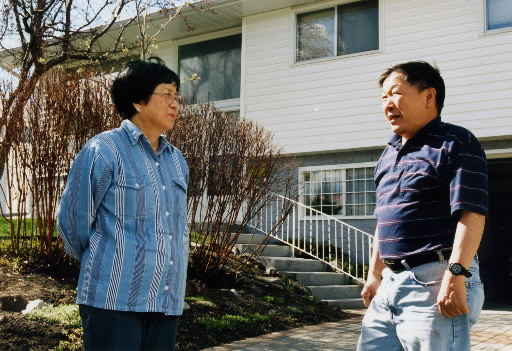Hiroshima Girls, Part 1: Life in Canada [1]
Jul. 3, 2010
Former "Hiroshima Girl" recounts her life of 30 years in Canada
by Masami Nishimoto, Staff Writer
This feature series on the "Hiroshima Girls," also known as "Hiroshima Maidens," is a close look at a number of Japanese women who were impacted by the atomic bombing of Hiroshima. The series was originally published in 1996.
The lobby of the Calgary International Airport was crowded with school girls in their sailor-style uniforms. "We often see Japanese students here on school trips," said Misako Tachibana, 66, in a slight accent which hinted at her Hiroshima roots. Turning from the students, she hurried to the exit.
Calgary is the largest city in the Province of Alberta and the gateway to the Rocky Mountains. The city, with a population of 720,000, hosted the Winter Olympics in 1988 and is still growing as a tourist destination and a supplier of natural gas and petroleum.
"I have a driver's license, but my husband always gives me a ride." She introduced her husband to me, speaking Japanese with a sprinkling of English words. Ms. Tachibana has been living in Canada for exactly 30 years.
On our way to her home, she turned back to me from the front seat and spoke in a firm tone, "I'm no longer a 'Hiroshima Girl,' and I don't want your article to be a tearjerker." A news article had once described her as an orphan although her parents were alive and well at the time. Did the ache of that incident cause lingering distrust? Glaring early summer sunshine poured into the car.
In 1955, with the cooperation of Japanese and American citizens, 25 unmarried women traveled to the United States from Hiroshima. They were to receive surgery for their keloids, the dreadful scars wrought by the heat of the atomic bomb. Misako Kannabe, Ms. Tachibana's maiden name, was among them. A slight trace of the skin graft can still be seen on her left cheek. The ring and little fingers on her left hand remain bent inward and don't move freely.
The uncomfortable combination of "A-bomb" and "Maiden" followed the 25 young women. Back in Japan after a year and a half of surgical treatment, this distressing epithet weighed heavily upon them. Before long, most of them refused to speak about their experiences.
"I'm not saying I hate talking about my experience," Ms. Tachibana said. "In fact, my experience of the bombing has spurred me, more than anything, to remain strong and never lag behind others. I want you to understand this about me, first of all." At this point, we approached a residential area sprawled atop rolling hills.
Her house, striking a lovely contrast between the white walls and the green lawn, stands on a lot of 4,500 square meters. It has two bedrooms, a living room, a dining room, a bathroom, and a basement, which is typical of Canadian houses and is the size of the total floor space above ground. Two years ago, they purchased the house for 150,000 Canadian dollars.
Before, they lived in Winnipeg, Manitoba, in central Canada, 1,300 kilometers to the east. Ms. Tachibana and her husband were both immigrants to that city, which is where they met. When they decided to move to Calgary, Ms. Tachibana retired as a beautician, though she had obtained a beautician's license in three different countries. Her husband retired from a travel agency this year.
"We should enjoy our lives while we're healthy, shouldn't we?" she said with a smile while relaxing on the sofa. She visited the United States twice from Hiroshima, and then settled in Canada. Her tone grew more enthused as she continued speaking about her life.
(Originally published on June 17, 1996)








